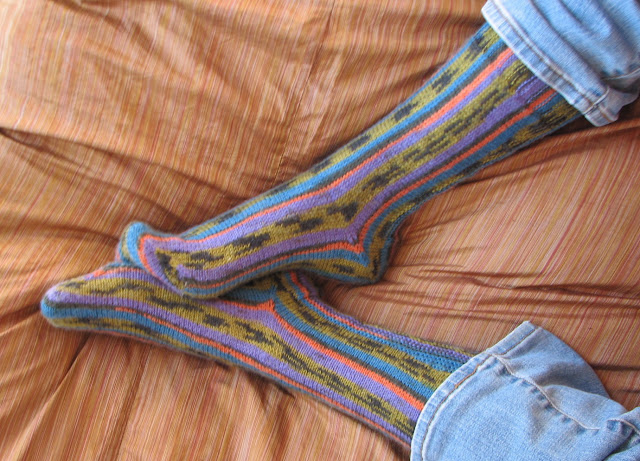I once had a therapist who told me that "the last 5% takes 95% of the effort" - who would have guessed that she was talking about
a pair of socks I would knit eighteen years later. Almost every part of these socks was knit twice.
This pattern,
Spread Spectrum, is designed to be done in one piece with intarsia, an afterthought heel, and a wedge toe worked in the round after picking up stitches at the end of the foot. It took me very little time to realize that intarsia really wasn't very much fun. (I've been spoiled, I guess, by starting intarsia projects with crochet - so much easier.) A delightful brainwave, though, I was able to immediately apply what I had learned from making
Stripe Tease socks, changing the method of construction completely but not the actual architecture or end result:
The bands of the cuff were made one at a time, joining as I went by incorporating slipped stitches picked up from the edge of the previous band. Aside from the lace patterned cuff, the only variation in the cuff bands was the number of stitches / width of each band. Don't forget, when you cast on, to add selvedge stitches, one for every seam!
The foot of the cuff was cast on as a separate piece, and joined to the cuff piece using slipped stitches on the instep only. The rest of the cuff and foot edge stitches were left unattached to make a base for an afterthought heel.
Sock #2 defied me over and over. It started when I kitchenered the cuff into a tube and learned at the end that I had two stitches more on one side than the other. Which meant all my bands were misaligned - too egregious to just fudge the extra stitches at the end of the kitchener. At one point making the foot, I discovered my stitch count was off, and found a dropped stitch more than half-way up the piece. Ribbit, ribbit. I accidentally attached the foot and cuff backwards, so the kitchenered seam of the cuff would have been in the front of the sock.
Then the finishing. For some reason the toes turned out different lengths. I adjusted the length of the foot panels because I thought I knew better than the pattern, and the foot came out too long. I tried a standard afterthought heel on one sock and a star heel on the other. Then I put the damn things on, and the fit was terrible. The seam under the toes bothered me. The fit at the heel was too tight. The foot was too long and the toe was too short.
So I photographed them for posterity, and ripped them out up to the cuff. Well, my daughter got to do that part because how often does a four-year-old get to frog an entire sock foot without getting in trouble?
I remade the bottom part of the sock using a Sweet Tomato Heel and the Stripe Tease pattern. Though the stitches go in the normal direction, it still shows off the yarn in an interesting way, and the fit is much better.
The yarn was gifted to me, and is all exactly my favorite sorts of colors except that really bright neon green. I haven't decided yet whether to overdye the socks and leftover yarn to tone that one shade down a bit. The effect of these socks would be ruined if the color variegation weren't visible.
Was glad to do this pattern once, but won't tackle it again. The effect of using variegated yarn in narrow bands to better show the colors can be achieved in Stripe Tease without the fit challenges of a sideways sock. Also the sideways construction of the cuffs makes them slouch.








